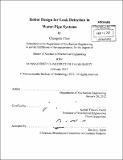Robot design for leak detection in water-pipe systems
Author(s)
Choi, Changrak
DownloadFull printable version (14.38Mb)
Other Contributors
Massachusetts Institute of Technology. Dept. of Mechanical Engineering.
Advisor
Kamal Youcef-Toumi.
Terms of use
Metadata
Show full item recordAbstract
Leaks are major problem that occur in the water pipelines all around the world. Several reports indicate loss of around 20 to 30 percent of water in the distribution of water through water pipe systems. Such loss of water represents critical waste of valuable resources, especially in countries such as Saudi Arabia where water is scarce. Moreover, leaks provide pathways for outside contaminants to enter into water pipe system which can deteriorate the quality of water and pose health risks to those drink from it. Considering these negatives, the importance of detecting where the leaks occur within vast network of water pipe system cannot be overemphasized. Further, for accurate and effective detection of the leaks, an in-pipe approach is taken which differs from previous detection methods. This thesis is on the design of mobile robotic platform that carries the necessary sensor and travels inside the water pipe systems. To begin with, experiments were carried out to investigate the suitability of using acoustic sensor to detect the leaks and favorable results were obtained. Then design specification of the mobile robotic platform that will carry the sensor is discussed with brief description of each components of the robot given. As components for the mobile robotic platform, a rigid-flexible robotic joint is developed that enables the robot to travel through bends and turns. Further, a novel braking mechanism using permanent magnet is presented. The mechanism results in a friction controllable leg that can be used to slow down and control the speed of robot in the presence of water flow. Finally, possible candidates for propulsion unit are discussed and evaluated with guidance for future work to be progressed.
Description
Thesis (S.M.)--Massachusetts Institute of Technology, Dept. of Mechanical Engineering, 2012. Cataloged from PDF version of thesis. Includes bibliographical references (p. 113-116).
Date issued
2012Department
Massachusetts Institute of Technology. Department of Mechanical EngineeringPublisher
Massachusetts Institute of Technology
Keywords
Mechanical Engineering.